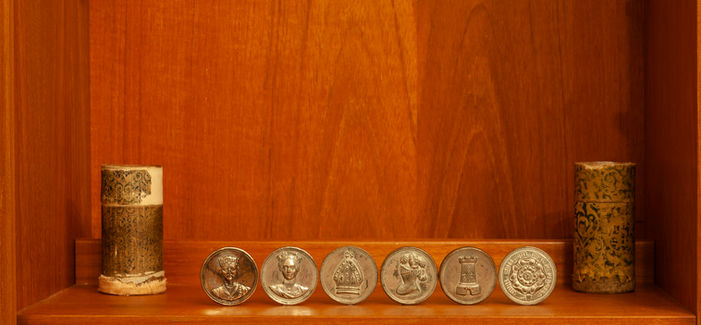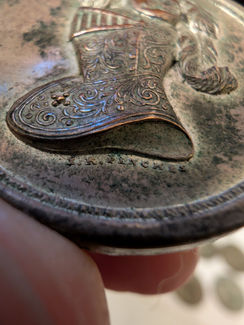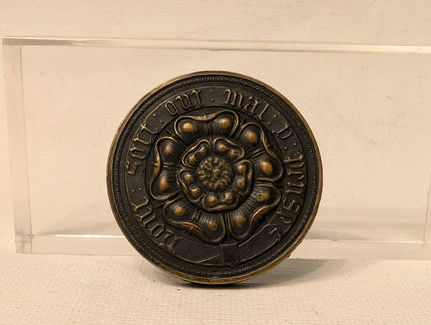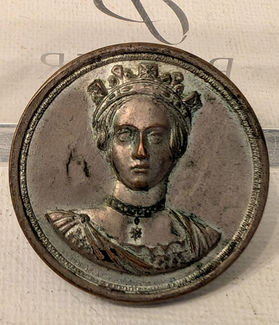
Neotypos disc chess by Pinches and Billiter, 1849
A bit of a rarity, this one - I have only heard of four other examples sold since 2005.
Pinches and Billeter were located at 27 Oxenden Street, London, and their design for the "Neotypos" chessmen was registered on October 8th in 1849, the same year that Nathaniel Cook registered the rather more famous Staunton design. The 16 "white" and 16 "black" pieces are housed in their own cardboard tubes, each of which should sport a large Victorian registration lozenge with the details - sadly one end was missing from this set. The discs are just over 1.4" in diameter.
Thomas Ryan Pinches appears to have been working as a "Medallist and seal engraver", and I have seen another example of his signed work on a Carisbrooke Castle commerative medal. Thomas established his business under his own name in 1841, before joining with William Billiter in 1849. William is listed in the Post Office Directory 1852 as a "medallist, see Pinches & Billiter"
The company only existed as "Pinches and Billiter" between 1849 and 1851, and is listed under "Medallists" in the Post Office London Directory (1851 Post Office/Kelly London Directories p.1284). The company went on to become one of the most famous and well regarded medallist companies in London, after Thomas and John went their separate ways (Thomas focussing on stationery, and John continuing the medallist business). It was eventually sold to the Franklin Mint in 1969 (full circle, you could say, since the Franklin Mint are known for their metal chess sets!).
The king and queen are beautifully modelled - I had initially read after a young Prince Albert and Queen Victoria (who really draws you back into the period in a very wonderful way), but fellow collector Larry Cates posited that the king looks more likely to be based on the Victorian vision of William the Conqueror. I think this is a very good call! To back this up, Larry also pointed out that Prince Albert was never actually a crowned king, and, in his opinion, it might have rankled Victorian sensibilities to have a "foreigner" as the king. Perhaps the designers were paying homage to Queen Victoria by aligning her with King William. Whatever the truth, the kings are signed just underneath the figure as "T.R. & W Pinches Fec.", (Thomas and his brother, William) and the knights (modelled as knight's helmets, rather than their steeds) are also signed, but more simply as just "T.R.Pinches".
The pieces are not solid metal - they are a thick electrotype shell, which I believe was then filled an enamelled leather (this information came courtsey of the wonderful Jon Crumiller, who sent me an article detailing this in "Family Friend" from 1850. I had initially thought that the enamelled leather was wax) before a black felt was added to finish the disc. The light side is silvered, whilst the dark side is bronzed.
*Electotyping is a facinating electrolysis process - a negative mould, taken from a carving, is treated to make it conductive to electricity (potentially through the addition of a graphite powder coating or silvering), and then immersed in a bath of appropriate copper solution with electrodes attached to the mould via a graphite rod (as the cathode) and copper sheet anodes; the apparatus is then hooked up to a DC source and left overnight - the copper ions are deposited on the cathode (mould) and build up to form a metal shell - an exact as possible replica of the original item that the mould was taken from. This is then further silvered in the case of the white side through a similar process (but this time just electroplating, rather than electrotyping).
The Sun newspaper, London, carried the following review on the 6th December 1849:
"NEOTYPOS CHESSMEN. An entirely novel and in some respects a peculiarly ingenious set of chessmen has just appeared - adaptable on occasions to the games of chess, draughts, and backgammon. They are flat and circular, with an embossed effigy representing the different men in the game of games. To amateurs we doubt not they will prove acceptable, though we are equally certain they would have been discarded by a Staunton, a Phillidor, or a De la Bourdon"
The Satirist (or Censor of the Times) had a slightly more flattering review on October 13th 1849:
"Yes, in answer to a Chess-Player. We have had submitted to us for inspection, a new set of chessmen and board, invented by Messrs. Pinches and Billiter, of Oxendon Street, called the Neotypos Chessmen, and we do not hesitate to state that from their portability and convenience, being adapted both far railway and shipboard playing, as well as from their elegance, forming an essential to the drawing room, professionals as well as amateurs will most extensively adapt them."
And The Era on 14th October 1849 also approved!
"THE NEW PORTABLE CHESS TABLE AND MEN.- Something is always coming out to meet the wants of men and suit their convenience. What we actually stand in need of is nothing to what is offered to us as a luxury. Now, the latest novelty that has met our eye is a little parcel comprising a chess board and a set of men made especially for use in railway carriages. The board is soon adjusted on the knees, or by fixing it to the side of the carriage or the seat. The pawns are all flat, like pennies, having their titles stamped upon them, and prepared so as to attach themselves to the positions in which they are placed without fear of derangement. The whole contrivance is very ingenious, and suited to steamboats, yachts, and other vessels, as well as all kinds of conveyances by land. Travelling by rail is found to be very monotonous and tedious, and offering little to divert the attention; and here we have a pleasant plan for whiling away the time, cleverly conceived, and, like all really useful in- ventions, simple. The inventors names are Pinches and Billiter, of 27, Oxenden Street, and the invention itself is termed Neotypos Chess Men. We have seldom to approve of the names of new things, and we believe that many useful articles never get into general use because of the difficulty of recollecting what they are called; this, however, will hardly fail to be sought after, for of all the thousands who admire Chess, who would not desire one of these Neotypos, as something calculated to lessen even a journey by rail"
ID | Century | Size | Maker | Nationality | Sold? |
|---|---|---|---|---|---|
186 | 19th | 1.41" | Pinches & Billiter | English | no |


















